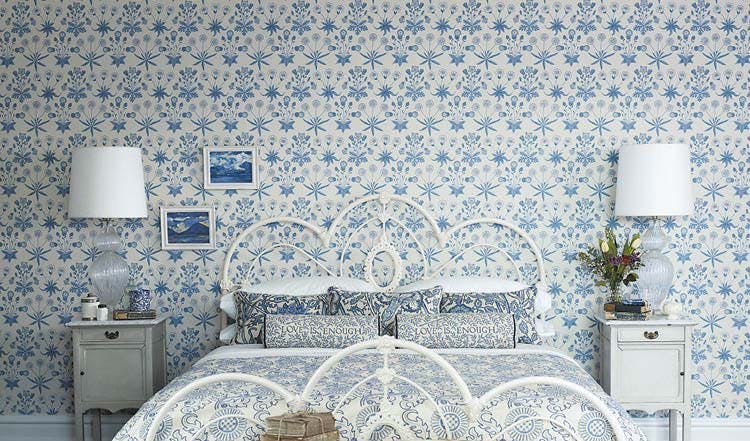
- Magazine Article
- Exhibitions
Not That Kind of Victorian
William Morris’s iconic Arts and Crafts style is more popular than ever

Persistent Pattern, A modern iteration in blue and cream of Daisy, the first wallpaper produced by Morris & Co.
William Morris celebrated the thrushes in the garden of his country home, Kelmscott Manor, by designing the now iconic pattern Strawberry Thief. He could never have imagined that the design would be in use 135 years later on items as varied as Dr. Martens combat boots and tea cozies. Designed in 1883, Strawberry Thief remains one of many Morris patterns that have been in production for more than a century, countering the stereotype of Victorian design as old-fashioned and irrelevant. William Morris (1834–1896) is unique among 19th-century English designers for weathering the inevitable backlash of successive generations; today his patterns are available in a bewildering array of forms inconceivable even to the visionary designer himself. Contemporary, minimalist style may seem at odds with the pattern-on-pattern aesthetic associated with Morris, but it is sympathetic to his motto “Have nothing in your houses that you do not know to be useful, or believe to be beautiful.”
When the design firm that Morris formed in 1861 closed in 1940, its archives were purchased by the British interior design firm Arthur Sanderson & Sons. Morris wallpaper and textiles continue to be produced under the UK company Style Library, which provided the wallpaper Fruit featured in the current exhibition William Morris: Designing an Earthly Paradise. In addition to the traditional colorways, Morris designs are available through Style Library in new shades that appeal to modern design sensibilities. For example, a room featured on the company’s website is hung with a simplified version of Daisy. Registered in 1864, Daisy was the second wallpaper Morris designed and the first produced. The blue-and-cream pattern illustrated here is a color option that would not have existed in the design firm’s original inventory. Re-creating a sense of the densely patterned Morris aesthetic, the pillows on the bed read Love Is Enough, the title of a play written by Morris proclaiming the significance of love over wealth or power.

An ardent Socialist, Morris struggled with the fact that goods produced from the finest materials by justly paid workers in a healthy environment meant that the objects were too expensive for the average consumer. He would likely have been disturbed by the glut of cheaply made items now bearing his designs. Artist David Mabb created the Morris Kitsch Archive, which documents 520 examples of Morris patterns found on mass-produced objects, including a baby’s changing mat, a hammer, and a dog’s T-shirt. After seeing a pair of Wellington boots printed with Morris’s Daisy pattern in the gift shop at the Victoria & Albert Museum in London, he was prompted to explore his simultaneous feelings of magnetism and revulsion. Mabb reproduced images of these goods for the 2009 exhibition Have nothing in your houses that you do not know to be useful, or believe to be beautiful at Leo Kamen Gallery in Toronto. While the ubiquity of Morris patterns in the 21st century represents a commercialization that would have troubled the Victorian crusader for sustainability and workers’ rights, it also testifies to the timelessness of his fundamental design principles and the beauty of his color harmonies.

Even as Morris patterns are found on trash cans and notebook covers, high-end designers continue to be attracted to his noble convictions that one should intimately understand the materials and process before embarking on a design and that only the finest materials should be used in order to ensure longevity. Inspired by Morris’s passionate, holistic approach, Jonathan Anderson, designer for the Spanish luxury brand Loewe, used iconic Morris & Co. patterns for its Fall 2017 collection. “I liked this idea of hybridizing Morris with the punk movement in Britain,” the designer said at the time. “When he started doing what he did, it was progressive. . . . He changed how we looked, the way in which we lived.”1 This capsule collection offered pieces meant to function together as modern camouflage, an effect immediately apparent in a store window in Madrid filled with objects emblazoned with Strawberry Thief. With items ranging from a $490 key chain to a $3,250 handbag, the Loewe goods actually have much in common with Morris’s original price points, if not his product types. Anderson joins designers such as Dries van Noten, Mary Katrantzou, and Tory Burch who see in Morris’s attention to craftsmanship the antidote to fast fashion. Generations after Morris, anxieties about mass production persist, and his designs appeal to consumers at opposite ends of the kitsch/couture spectrum.